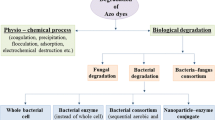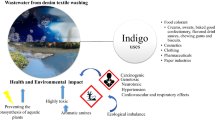Abstract
In this study, Bacillus cereus isolate from tannery effluent was employed for orange II dye decolorization in simulated minimal salt broth and textile effluent. Most of the physicochemical parameters of textile effluent were above the permissible limits. The strain was highly tolerant to dye up to 500 mg l−1. Increasing dye concentration exerted inhibitory effect on the bacterial growth and decolorization. The maximum decolorization of initial 100 mg dye l−1 was achieved at optimum pH 8.0 and 33 °C under static culture conditions during 96-h incubation. Supplementation with optimized glucose (0.4 %, w/v) and ammonium sulfate (0.1 %, w/v) with 3.0 % B. cereus inoculum further enhanced dye decolorization to highest 68.5 % within 96-h incubation. A direct correlation was evident between bacterial growth and dye decolorization. Under above optimized conditions, 24.3 % decolorization of unsterilized real textile effluent by native microflora was achieved. The effluent decolorization enhanced substantially to 37.1 % with B. cereus augmentation and to 40.5 % when supplemented with glucose and ammonium sulfate without augmentation. The maximum decolorization of 52.5 % occurred when textile effluent was supplemented with optimized exogenous carbon and nitrogen sources along with B. cereus augmentation. Gas chromatography–mass spectrometry identified sulfanilic acid as orange II degradation product. Fourier transform infra red spectroscopy of metabolic products indicated the presence of amino and hydroxyl functional groups. This strain may be suitably employed for in situ decolorization of textile industrial effluent under broad environmental conditions.








Similar content being viewed by others
References
Acuner, E., & Dilek, F. B. (2004). Treatment of tectilon yellow 2G by Chlorella vulgaris. Process Biochemistry, 39, 623–631.
Agarry, S. E., & Ajani, A. O. (2011). Evaluation of microbial systems for biotreatment of textile waste effluents in Nigeria: biodecolorization and biodegradation of textile dye. Journal of Applied Science and Environmental Management, 15(1), 79–86.
Aksu, Z. (2003). Reactive dye bioaccumulation by Saccharomyces cerevisiae. Process Biochemistry, 38, 1437–1444.
Alalewi, A., & Jiang, C. (2012). Bacterial influence on textile wastewater decolorization. Journal of Environmental Protection, 3, 1–12.
Ali, N., Hameed, A., & Ahmed, S. (2010). Role of brown-rot fungi in the bioremoval of azo dyes under different conditions. Brazilian Journal of Microbiology, 41, 907–915.
A.P.H.A. (1998). Standard methods for examination of water and wastewater, 20th ed. Washington DC, USA: American Public Health Association, American Water Works Association and Water Pollution Control Federation.
Asad, S., Ammozegar, M. A., Sarbolouki, M. N., & Dastgheib, S. M. M. (2007). Decolorization of textile azo dyes by newly isolated halophilic and halotolerant bacteria. Bioresource Technology, 98, 2082–2088.
Asgher, M., Bhatti, H. N., Shah, S. A. H., Asad, M. J., & Legge, R. L. (2007). Decolourization potential of mixed microbial consortia for reactive and disperse textile dyestuffs. Biodegradation, 18, 311–316.
Banat, I. M., Nigam, P., Marchant, R., & Singh, D. (1996). Microbial process for the decolourization of textile effluent containing azo, diazo and reactive dyes. Process Biochemistry, 31, 435–442.
Bayoumi, R. A., Musa, S. M., Bahobil, A. S., Louboudy, S. S., & El-Sakawey, T. A. (2010). Biodecolorization and biodegradation of azo dyes by some bacterial isolates. Journal of Applied Environmental and Biological Sciences, 1, 1–25.
Chen, K. C., Huang, W. T., Wu, J. Y., & Houng, J. Y. (1999). Microbial decolorization of azo dyes by Proteus mirabilis. Journal of Industrial Microbiology and Biotechnology, 23, 686–690.
Cooper, P. (1995). Colour in dyehouse effluent (pp. 9–21). Bradford: Society of Dyers and Colourists, Alden Press.
Dayaram, P., & Dasgupta, D. (2008). Decolourization of synthetic dyes and textile wastewater using Polyporus rubidus. Journal of Environmental Biology, 29(6), 831–836.
Deng, D. Y., Guo, J., Zeng, G. Q., & Sun, G. P. (2008). Decolorization of anthraquinone, triphenylmethane and azo dyes by a new isolated Bacillus cereus strain DC11. International Biodeterioration and Biodegradation, 62, 263–269.
Franciscon, E., Zille, A., Fantinnatti-Garboggini, F., & Silva, I. S. (2009). Microaerophilic-aerobic sequential decolourisation/biodegradation of textile azo dyes by a facultative Klebsiella sp. strain VN-31. Process Biochemistry, 44, 446–452.
Ghodake, G., Jadhav, U., Tamboli, D., Kagalkar, A., & Govindwar, S. (2011). Decolorization of textile dyes and degradation of mono-azo dye amaranth by Acinetobacter calcoaceticus NCIM 2890. Indian Journal of Microbiology, 51(4), 501–508.
Hu, T. L. (1994). Decolorization of reactive azo dyes by transformation with Pseudomonas luteola. Bioresource Technology, 49, 47–51.
Kaushik, P., & Malik, A. (2009). Microbial decolourization of textile dyes through isolates obtained from contaminated sites. Journal of Scientific and Industrial Research, 68, 325–331.
Kolhe, A. S., & Pawar, V. P. (2011). Physico-chemical analysis of effluents from dairy industry. Recent Research in Science and Technology, 3(5), 29–32.
Mane, U. V., Gurav, P. N., Deshmukh, A. M., & Govindwar, S. P. (2008). Degradation of textile dye reactive navy-blue Rx (Reactive blue-59) by an isolated actinomycete Streptomyces krainskii SUK-5. Malaysian Journal of Microbiology, 4(2), 1–5.
Manu, B., & Chaudhari, S. (2002). Anaerobic decolorization of simulated textile wastewater containing azo dyes. Bioresource Technology, 82, 225–231.
Meitiniarti, V. I., Soetarto, E. S., Timotius, K. H., & Sugiharto, E. (2007). Products of orange II biodegradation by Enterococcus faecalis ID6017 and Chryseobacterium indologenes ID6016. Microbiology Indonesia, 1, 51–54.
Mendez-Paz, D., Omil, F., & Lema, J. M. (2005). Anaerobic treatment of azo dye acid orange 7 under batch conditions. Enzyme and Microbial Technology, 36, 264–272.
Moosvi, S., Kher, X., & Madamwar, D. (2007). Isolation, characterization and decolorization of textile dyes by a mixed bacterial consortium JW-2. Dyes and Pigments, 74(3), 723–729.
Nishide, S., & Shoda, M. (2012). Comparative study on the decolorization of orange II by zero-valence tin in citric and hydrochloric acids. Energy and Environmental Science, 2, 1–12.
Nosheen, S., Nawaz, R., Arshad, M., & Jamil, A. (2010). Accelerated biodecolorization of reactive dyes with added nitrogen and carbon sources. International Journal of Agriculture and Biology, 12, 426–430.
Padmavathy, S., Sandhyan, S., Swaminathan, K., Subrahmanyam, Y. V., Chakrabarti, T., & Kaul, S. N. (2003). Aerobic decolourisation of reactive azo dyes in presence of cosubstrates. Chemical Biochemical Engineering Q, 17, 147–151.
Pearce, C. I., Lloyd, J. R., & Guthrie, J. T. (2003). The removal of colour from textile wastewater using whole bacterial cells: a review. Dyes and Pigments, 58, 179–196.
Ponraj, M., Gokila, K., & Zambare, V. (2011). Bacterial decolorization of textile dye-orange 3R. International Journal of Advanced Biotechnology and Research, 2, 168–177.
Pourbabaee, A. A., Malekzadeh, F., Sarbolouki, M. N., & Mohajeri, A. (2005). Decolorization of methyl orange (As a model azo dye) by the newly discovered Bacillus sp. Iranian Journal of Chemical Engineering, 24, 41–45.
Pourbabaee, A. A., Malakzadeh, F., Sarbolouki, M. N., & Najafi, F. (2006). Aerobic decolourization and detoxification of disperse dye in textile effluent by a new isolate of Bacillus sp. Biotechnology and Bioengineering, 93, 631–635.
Sahoo, D. K., & Gupta, R. (2005). Evaluation of ligninolytic microorganisms for efficient decolorization of a small pulp and paper mill effluent. Process Biochemistry, 40, 1573–1578.
Singh, P., & Thakur, I. S. (2004). Removal of colour and detoxification of pulp and paper mill effluent by microorganisms in two step bioreactor. Journal of Scientific and Industrial Research, 63, 944–948.
Snehal, V. M., Sheeja, J., Rao, B. S., Balachandranan, U. N., & Laxman, R. S. (2002). Chromium removal and reduction in COD of tannery effluents. Indian Journal of Environmental Health, 44, 320–328.
Spadaro, J. T., Gold, M. H., & Renganathan, V. (1992). Degradation of azo dyes by the lignin-degrading fungus Phanerochaete chrysosporium. Applied and Environmental Microbiology, 58, 2397–2401.
Tripathi, A., & Srivastava, S. K. (2011). Ecofriendly treatment of azo dyes: biodecolorization using bacterial strains. International Journal of Bioscience Biochemistry and Bioinformatics, 1, 37–40.
Tripathi, M., Vikram, S., Jain, R. K., & Garg, S. K. (2011). Isolation and growth characteristics of chromium (VI) and pentachlorophenol tolerant bacterial isolate from treated tannery effluent for its possible use in simultaneous bioremediation. Indian Journal of Microbiology, 51(1), 61–69.
Trivedi, R. K., Khatavkar, S. B., & Goel, P. K. (1986). Characterization, treatment and disposal of waste water in a textile industry. Journal of Industrial Pollution Control, 2(1), 1–12.
Zimmermann, T., Kulla, H. G., & Leisinger, T. (1982). Properties of purified Orange II azoreductase, the enzyme initiating azodye degradation by Pseudomonas KF46. European Journal of Biochemistry, 129, 197–203.
Acknowledgments
The authors express sincere thanks to Central Instrumentation Facilities, National Institute of Pharmaceutical Education and Research, Chandigarh, India for GC-MS and FT-IR analyses. Facilities provided by the Government of Uttar Pradesh under Centre of Excellence and Government of India’s DST-FIST schemes are duly acknowledged.
Author information
Authors and Affiliations
Corresponding author
Rights and permissions
About this article
Cite this article
Garg, S.K., Tripathi, M. Process parameters for decolorization and biodegradation of orange II (Acid Orange 7) in dye-simulated minimal salt medium and subsequent textile effluent treatment by Bacillus cereus (MTCC 9777) RMLAU1. Environ Monit Assess 185, 8909–8923 (2013). https://doi.org/10.1007/s10661-013-3223-2
Received:
Accepted:
Published:
Issue Date:
DOI: https://doi.org/10.1007/s10661-013-3223-2




